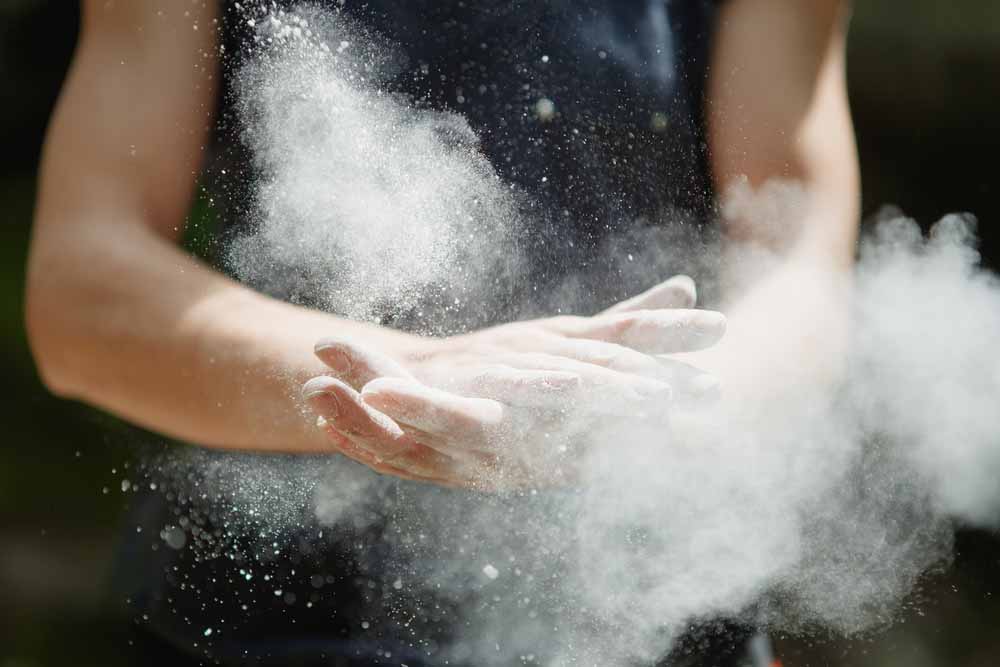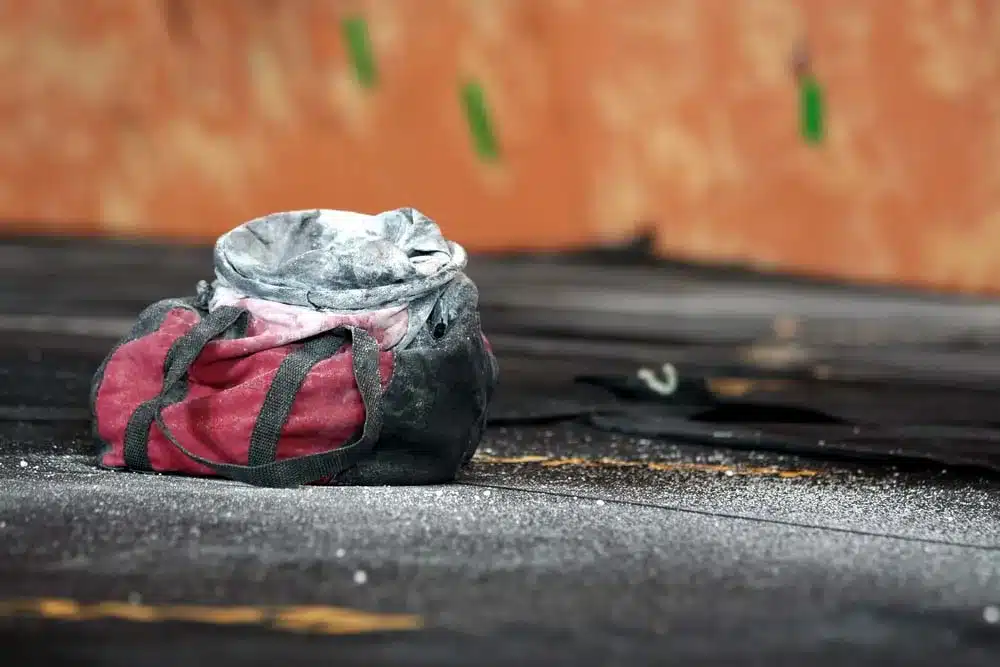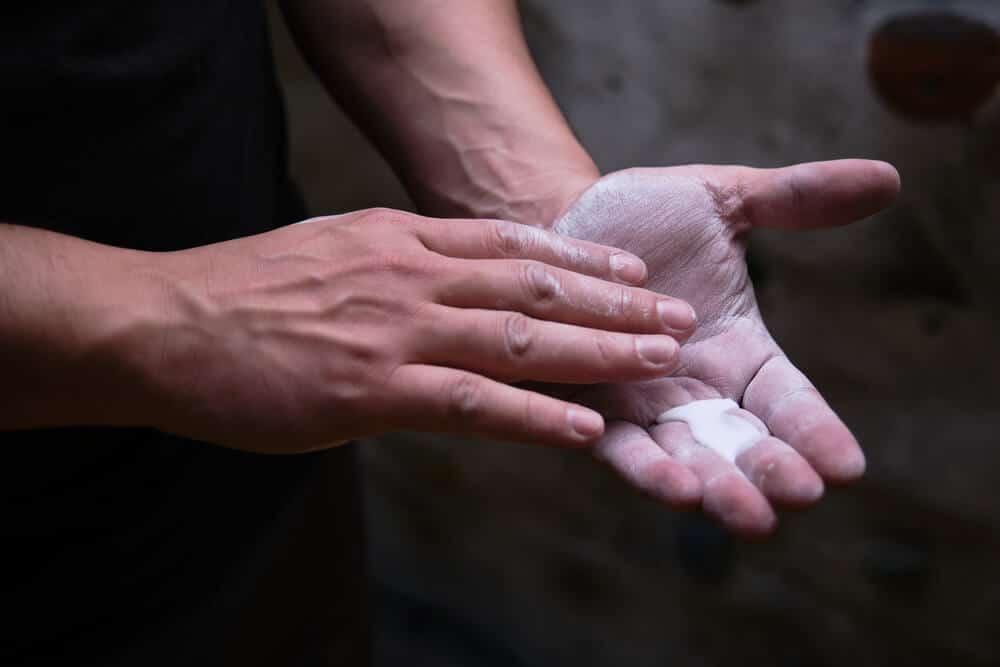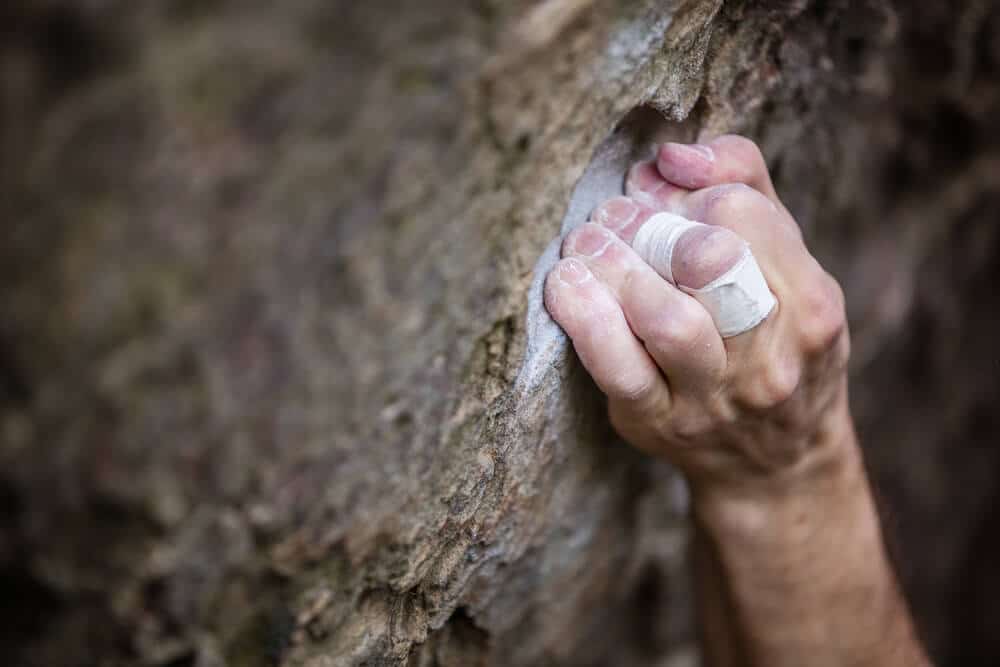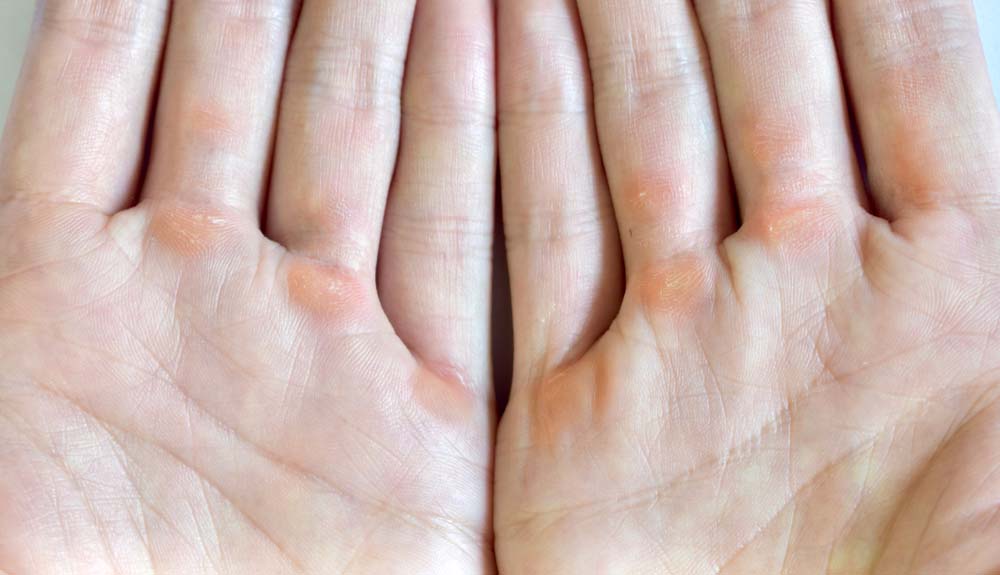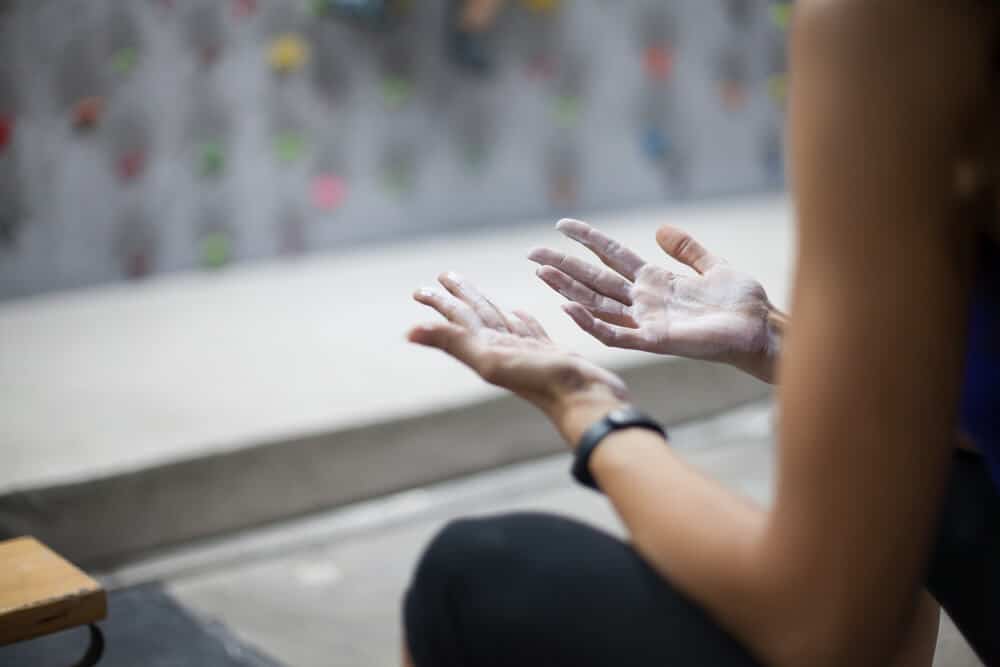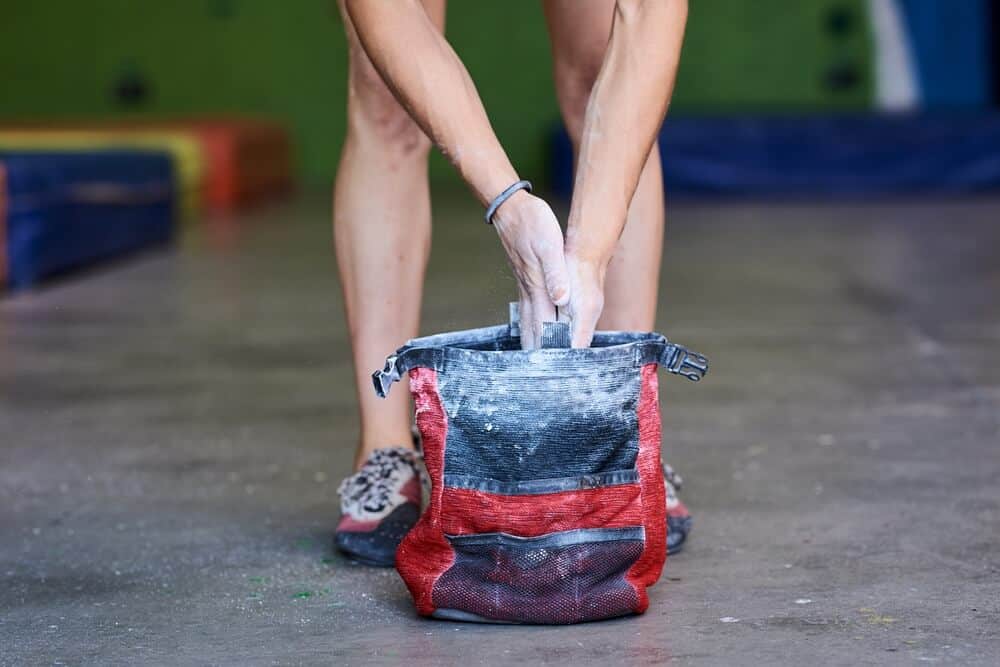Almost all climbers use chalk when they climb. Chalking up absorbs the moisture on sweaty hands and helps them stick to holds instead of slipping off. In recent years, more and more climbers have started to use liquid chalk. If you’ve only ever used loose climbing chalk, you might be wondering what liquid chalk is and if you should make the switch.
A brief chalk history
Chalk was first used in climbing in the 1950s. It was introduced to the sport by John Gill, a climber who helped people recognize bouldering as a legitimate discipline of hard climbing.
As Gill began to ascend short, acrobatic climbs, he needed a way to dry his sweaty hands. He was familiar with powder chalk from his background in gymnastics, and started using it for climbing.
Is chalk considered cheating?
Gill’s idea was a game changer, and soon the trend caught on – many climbers started using powdered chalk.
However, some climbers viewed the use of dry chalk as cheating, as it made the climbs easier. Slowly this perception faded away, though there have been a few climbers in recent history who have felt this way.
However, most of us swear by the stuff, and it’s become a large market within the climbing industry.
Regular chalk is sold as a powder form or in solid blocks, and you can also purchase things such as chalk balls.
It’s not just for climbing – gym chalk is used in weight lifting and gymnasts commonly use block chalk for bar routines. There’s another type of climbing chalk too: liquid chalk.
What is liquid chalk?
The main ingredient in both liquid and dry chalk is magnesium carbonate. Other ingredients are often added to enhance the drying properties.
The main difference between liquid and dry chalk is that in contrast to powder chalk, liquid chalk has an alcohol base. When you apply the chalk to your hands, the alcohol quickly evaporates, leaving your hands covered in a powdery layer.
To use liquid chalk, simply squeeze a dime sized amount onto your hands and rub your hands together, distributing the liquid evenly. Wait a few seconds for the alcohol to properly evaporate, and then you’re good to go!
Liquid chalk vs powdered chalk
There’s a lot to consider when you’re deciding which type of chalk is best for you, but the most important question, is of course, which one works better? Let’s dive into the pros and cons of liquid chalk as compared to powdered chalk.
Pros of liquid chalk
If you’re deciding whether to use powdered chalk or liquid chalk, there are a few things to consider. Liquid chalk definitely has some advantages over regular chalk.
Less mess
Have you ever spilled your powder chalk all over the gym floor or created a big mess of dust outside? It seems like no matter how careful you are, making a mess with conventional chalk is kind of inevitable. It’s much easier to stay clean with liquid chalk, and you’ll never get chalk dust on the gym floor.
More hygienic
Using liquid chalk can be more hygienic than traditional chalk. You can easily share chalk with a friend without dipping hands into the same chalk bag. Instead, you can each squirt a bit of chalk onto your hands as needed.
Plus, since liquid chalk usually contains alcohol, it can actually have some sanitizing properties. Friction labs even makes liquid chalk that’s specially designed to sanitize your hands. This is especially useful for reducing the spread of germs in crowded gyms.
Lower environmental impact
If you’re using a resin-free brand of liquid chalk, it’s likely to be better for the environment (more on resin in the following section). Using liquid chalk means less chalk is left behind on the rock or plastic. When you squirt liquid chalk onto your hands, you end up with a thin layer of chalk– no extra dust like powdered chalk produces.
This is nice when climbing in the gym, because it means the holds get less greasy– we all know how frustrating it is to try to slip off of greased up slopers. It’s even more important when climbing outside, because chalk leaves residue on the rock that can have negative environmental impacts.
For one, there’s the visual pollution that white holds creates. Non-climbers who come to visit beautiful natural sites may be disappointed to see lines of white marks on the cliffs. Some places, like Garden of the Gods park in Colorado have banned chalk altogether in order to preserve the natural character of the park. Other spots, like Arches National Park in Utah, only allow chalk that matches the color of the rock.
It’s not only the visual impacts of chalk. Chalk dust also impacts the rock surface it’s applied to by changing the pH and nutrient availability. This impacts the livelihood of plants that dwell on rock, such as mosses and lichens. Thus, getting less chalk on holds lessens the impact on the native ecosystems.
The materials used to make chalk also have a large environmental impact in terms of their production. The mineral magnesite is used to make chalk, and this mineral is available only through mining. Magnesite is not only used for chalk; it’s also used to make synthetic rubber and even laxatives.
Magnesite then goes through a chemical refining process to create magnesium carbonate, which is the primary ingredient in climbing chalk. Magnesite is primarily mined in China, and the extraction of this mineral has consequences for the surrounding environment. Areas near magnesite mines have experienced plant loss and diminished soil quality as a result of mining operations.
Chalk is not necessarily worse for the environment than other types of gear– everything we use in rock climbing, and in our lives in general, has some sort of environmental impact in terms of its production. But in contrast to a carabiner that might last for decades, most of us go through lots and lots of chalk. Using liquid chalk can be a way to reduce your chalk consumption and thus lighten your environmental impact.
Better for your health
Air quality has been found to be a problem at some, though not all, climbing gyms, and some of this is likely due to chalk dust in the air. A detailed comparison between the air quality effects of liquid chalk vs dry chalk found that liquid chalk releases less dust particles into the air, making it a good choice in the gym.
Does liquid chalk prevent calluses and tears?
Most climbers love chalk and find it helps dry out sweaty palms and fingertips and improve grip strength. However, using too much chalk can actually be bad for your skin. By increasing the friction between your skin and the rock, chalk can contribute to skin tears or rips. Thus, liquid chalk can help your skin health by controlling the amount of chalk that’s on your hands.
Cons of liquid chalk
There are some reasons why some people prefer to use powdered chalk.
Harder to chalk up
The largest drawback to liquid chalk, in my opinion, is that it’s much harder to chalk up mid route. Liquid chalk typically comes in a tube that you have to squeeze, making it virtually impossible to re-chalk your hands mid-route.
Thus, liquid climbing chalk is probably a better choice for your bouldering session than it is for a sport climbing day.
Resin can damage climbs
Some brands of liquid chalk contain resin, which is a substance harvested from pine trees. Resin makes the liquid chalk stickier, and it also reduces the cost of producing the chalk. However, when you climb with resin-based chalk, the resin gets warmed by your hands and then sticks to the rock when you grab a hold.
This means a residue is left behind, and the rock can become slippery even faster than it would with dry chalk. This can make climbs more difficult and less enjoyable for other climbers, and this can happen both outdoors and in the gym. Thus, it’s best to pick a resin-free brand.
Performance
Some climbers do prefer the effects of dry chalk and find that liquid chalk sticks to the rock less well. I personally find that I feel a bit more confident on the rock with dry chalk– it seems to have a bit more of a drying effect on the sweat on my hands. However, other climbers love the liquid grip and prefer to use liquid chalk! In the end there’s probably not a huge difference in performance. Given all the other advantages of liquid chalk, I’d recommend at least giving it a try in the gym!
Best liquid chalk brands
If you’ve decided to give liquid chalk a try, you might be wondering which type to purchase. Here are a couple of good options!
-
Friction Labs Secret Stuff: This long lasting chalk is resin free, will keep your skin healthy, and performs well!
-
Another option for resin free chalk is the Pure Liquid Chalk from Wild Country. This chalk boasts “dust-free performance” and is competitively priced.
Conclusion
Chalk is an essential that you should always have in your gym bag! This article gave an overview of liquid chalk, including what is is and how to use it. You should now have a good understanding of the advantages that liquid chalk has, including environmental benefits, health benefits, and the fact that it’s much less messy. However, you’ll also understand why it doesn’t work well for sport climbing.
Liquid chalk and dry chalk both have their places, and both will help you stay on the wall! In the end, whether you choose liquid chalk or regular chalk will be a matter of personal preference.
Sources


